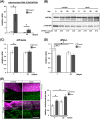Loss of BOSS Causes Shortened Lifespan with Mitochondrial Dysfunction in Drosophila
- PMID: 28045997
- PMCID: PMC5207625
- DOI: 10.1371/journal.pone.0169073
Loss of BOSS Causes Shortened Lifespan with Mitochondrial Dysfunction in Drosophila
Abstract
Aging is a universal process that causes deterioration in biological functions of an organism over its lifetime. There are many risk factors that are thought to contribute to aging rate, with disruption of metabolic homeostasis being one of the main factors that accelerates aging. Previously, we identified a new function for the putative G-protein-coupled receptor, Bride of sevenless (BOSS), in energy metabolism. Since maintaining metabolic homeostasis is a critical factor in aging, we investigated whether BOSS plays a role in the aging process. Here, we show that BOSS affects lifespan regulation. boss null mutants exhibit shortened lifespans, and their locomotor performance and gut lipase activity-two age-sensitive markers-are diminished and similar to those of aged control flies. Reactive oxygen species (ROS) production is also elevated in boss null mutants, and their ROS defense system is impaired. The accumulation of protein adducts (advanced lipoxidation end products [ALEs] and advanced glycation end products [AGEs]) caused by oxidative stress are elevated in boss mutant flies. Furthermore, boss mutant flies are sensitive to oxidative stress challenges, leading to shortened lives under oxidative stress conditions. Expression of superoxide dismutase 2 (SOD2), which is located in mitochondria and normally regulates ROS removal, was decreased in boss mutant flies. Systemic overexpression of SOD2 rescued boss mutant phenotypes. Finally, we observed that mitochondrial mass was greater in boss mutant flies. These results suggest that BOSS affects lifespan by modulating the expression of a set of genes related to oxidative stress resistance and mitochondrial homeostasis.
Conflict of interest statement
The authors have declared that no competing interests exist.
Figures







Similar articles
-
A Drosophila orphan G protein-coupled receptor BOSS functions as a glucose-responding receptor: loss of boss causes abnormal energy metabolism.Proc Natl Acad Sci U S A. 2008 Oct 7;105(40):15328-33. doi: 10.1073/pnas.0807833105. Epub 2008 Oct 1. Proc Natl Acad Sci U S A. 2008. PMID: 18832180 Free PMC article.
-
Differential Effects of Tissue-Specific Deletion of BOSS on Feeding Behaviors and Energy Metabolism.PLoS One. 2015 Jul 20;10(7):e0133083. doi: 10.1371/journal.pone.0133083. eCollection 2015. PLoS One. 2015. PMID: 26193363 Free PMC article.
-
The Drosophila 7-pass transmembrane glycoprotein BOSS and metabolic regulation: What Drosophila can teach us about human energy metabolism.Methods Enzymol. 2010;480:525-38. doi: 10.1016/S0076-6879(10)80024-2. Methods Enzymol. 2010. PMID: 20816226 Review.
-
A correlation of reactive oxygen species accumulation by depletion of superoxide dismutases with age-dependent impairment in the nervous system and muscles of Drosophila adults.Biogerontology. 2015 Aug;16(4):485-501. doi: 10.1007/s10522-015-9570-3. Epub 2015 Mar 24. Biogerontology. 2015. PMID: 25801590
-
Mitochondrial respiration and reactive oxygen species in mitochondrial aging mutants.Exp Gerontol. 2006 Mar;41(3):237-45. doi: 10.1016/j.exger.2006.01.004. Epub 2006 Feb 21. Exp Gerontol. 2006. PMID: 16497463 Review.
Cited by
-
G protein-coupled receptors that influence lifespan of human and animal models.Biogerontology. 2022 Feb;23(1):1-19. doi: 10.1007/s10522-021-09945-8. Epub 2021 Dec 3. Biogerontology. 2022. PMID: 34860303 Free PMC article. Review.
-
Regulation of Drosophila Lifespan by bellwether Promoter Alleles.Sci Rep. 2017 Jun 23;7(1):4109. doi: 10.1038/s41598-017-04530-x. Sci Rep. 2017. PMID: 28646164 Free PMC article.
-
Loss of Prune in Circadian Cells Decreases the Amplitude of the Circadian Locomotor Rhythm in Drosophila.Front Cell Neurosci. 2019 Mar 1;13:76. doi: 10.3389/fncel.2019.00076. eCollection 2019. Front Cell Neurosci. 2019. PMID: 30881291 Free PMC article.
-
Ageing, metabolism and the intestine.EMBO Rep. 2020 Jul 3;21(7):e50047. doi: 10.15252/embr.202050047. Epub 2020 Jun 21. EMBO Rep. 2020. PMID: 32567155 Free PMC article. Review.
References
-
- Tissenbaum HA, Guarente L. Model organisms as a guide to mammalian aging. Dev Cell. 2002;2(1):9–19. - PubMed
MeSH terms
Substances
LinkOut - more resources
Full Text Sources
Other Literature Sources
Molecular Biology Databases

